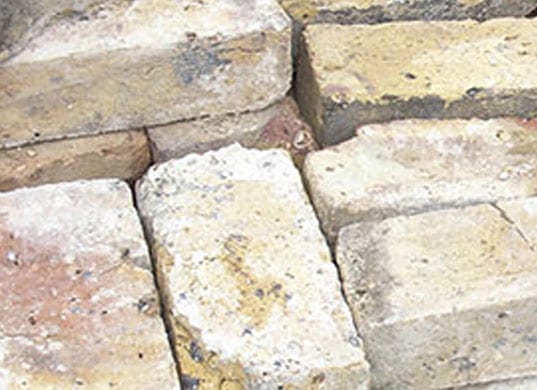Concrete as you know it today has only been used in house foundations for just over 100 years. In 1756 cement was produced by John Smeaton by baking crushed limestone with a proportion of clay and Joseph Aspdin first patented Portland Cement in 1824.

Bricks
Bricks were introduced into Britain by the Romans who also mastered the use of lime mortar which is why many of their structures are still standing today.
The brickmaker’s art was revived in the thirteenth century when the supply of recycled Roman bricks was exhausted but mainly for prestigious projects such as manor houses. The clay for making bricks was dug as near to where it was needed as possible, shaped in moulds, air-dried and fired in clamps. Even in the nineteenth century handmade bricks were fired on the actual building site. Bricks could be found in lesser buildings in the South-Eastern counties from around 1560 and in the north of England from around 1620.
Brick Measurements
A standard modern brick measures 215mm long by 102.5mm in breadth and 65mm deep. The first two measurements have remained fairly constant over the years but the depth has changed and this is a reliable way of aging a brick building. Before the middle of the sixteenth century, the bricks were 44.5mm deep, gradually thickening to about 57mm by 1725 and to 63mm after 1784, the year of the brick tax. Early brick production was unreliable and bricks were laid with large mortar joints to overcome this but as mass production from 1859 provided bricklayers with constant sized bricks, the mortar joints became increasingly smaller.
Brick Colouring
The colouring of bricks is determined by the chemistry of the local clays and the intensity of the firing but as a rough guide, intense reds could be found in the Midlands about 1720-1820, silver-grey was characterized by Thames Valley production of 1740-1810; yellow brown in London from 1780-1860 and yellow throughout southern England from 1790-1850.
Blocks
In the late 1920s blocks (equivalent) to six bricks, 3 high and 2 long, were first used in this country. Today most internal walls are built with some form of block’ as is the inner part of the outside wall.
Cavity Walls
These were also introduced in the 1920s either with two skins of bricks or with the new block and an outside skin of bricks. Houses built before the 1920s had been one brick thick (215mm) with no cavity. The strength was achieved by laying the bricks in (English Bond), three with the heads showing and two on top laid lengthways. This type of wall had a poor insulation value and was prone to damp.
Insulation Values of Walls
Heat loss is measured by its “U” value. The lower the number, the better the insulation. Modern homes achieve a “U” value of 0.45 whereas one brick Victorian homes are somewhere between 2.0 and 2.5.
Damp Proof Courses
First seen at the end of the Victorian period when materials such as tar and sand were used. Denser engineering bricks were also used as well as layers of slate to provide a barrier to rising damp, the later often cracked and failed as a DPC. Modern DPCs are synthetic and are usually placed about 150mm above ground level.
Ceilings
Lath and plaster was used up until the Second World War and consisted of small strips of timber nailed to the floor joists with gaps in between. The plaster was forced into the gaps and produced a flexible finish. Many of these ceilings remain today, even if they are a bit uneven, they take a great deal to bring down. The bombing of cities across England hastened the plasterboard as we know today and this enabled damaged buildings to be patched up quickly.
Glass
Very little before 16c. 1678 first Crown Glass was produced in London. 1834 Robert Lucas Chance introduced Improved Cylinder Sheet, finer quality larger panes used in the Crystal Palace. 1903, machine drawn cylinder glass invented in the USA manufactured by Pilkingtons until 1933. 1959 saw the introduction of Float Glass invented by Sir Alistair Pilkington.
Double Glazing
This contributes enormously to the heat efficiency of a house depending on the location of a dwelling, a single glazed window has a “U” value of 4.7 whereas double glazing with12mm gap and low-e gives a “U” value of 2.4.
Low Emissivity (‘low e’) Glass
Low emissivity refers to a treatment the glass receives which can reflect back heat into the house whilst allowing radiated heat from the sun to pass into the house.
The Flushing Toilet
Unfortunately as the butt of most jokes, the smallest room in the house has had a slow start. Back in the 16th century Sir John Harrington first invented a “washout” closet but it was 200 years before the idea caught on. In between was a reluctance to tackle the problem resulting in waste being thrown from upstairs windows onto unsuspecting pedestrians. A code of conduct was set up where a cry of “Garden l’eau” pronounced “Gardy-loo”, meaning watch out for the water, was uttered before release and this evolved into slang for the toilet or loo. Alexander Cummings patented the “S” trap toilet and such names as Doulton, Wedgwood, Shanks and Twyford would be early manufacturers. For further information on plumbing systems visit foxandco.co.uk
Water Supply
The Victorians introduced running water to houses before that water was collected in rainwater butts or obtained from local streams or wells. With the new beam engine, the Victorians were able to pump water from reservoirs directly into houses through cast iron pipes. The pressure was not as we know it today and that is why most bathrooms were situated downstairs.
Electrical Supply
The first public supplies were available in the early 1880s but the spread of this new energy was slow and at the outbreak of the First World War the majority of houses did not have a supply. In the 1920s and 30s manufacturers developed many of the household goods we take for granted today. Early wiring used rubber to insulate the live wires and an outer casing of lead to act as the earth. The early two pin sockets were changed to three pin earthed types in the 30s but they did not have a fuse. 13 amp sockets have been in use since the 1950s and the PVC cable has been in use for over thirty years.
Below Ground Drainage
Mains drainage in terms of the history of the house is a very new luxury. The Georgians had a rudimentary form of drainage but it was not until the end of the nineteenth century that it was an automatic requirement to provide a comprehensive system of mains drainage for all new houses in urban areas. The early drains were combined, that is to say foul and rainwater used the same pipework but only in the last 40 years have the two systems been separated. Most early pipework was made from clay and it was not until the 60s did we see the introduction of plastic underground foul and rainwater downpipes.







